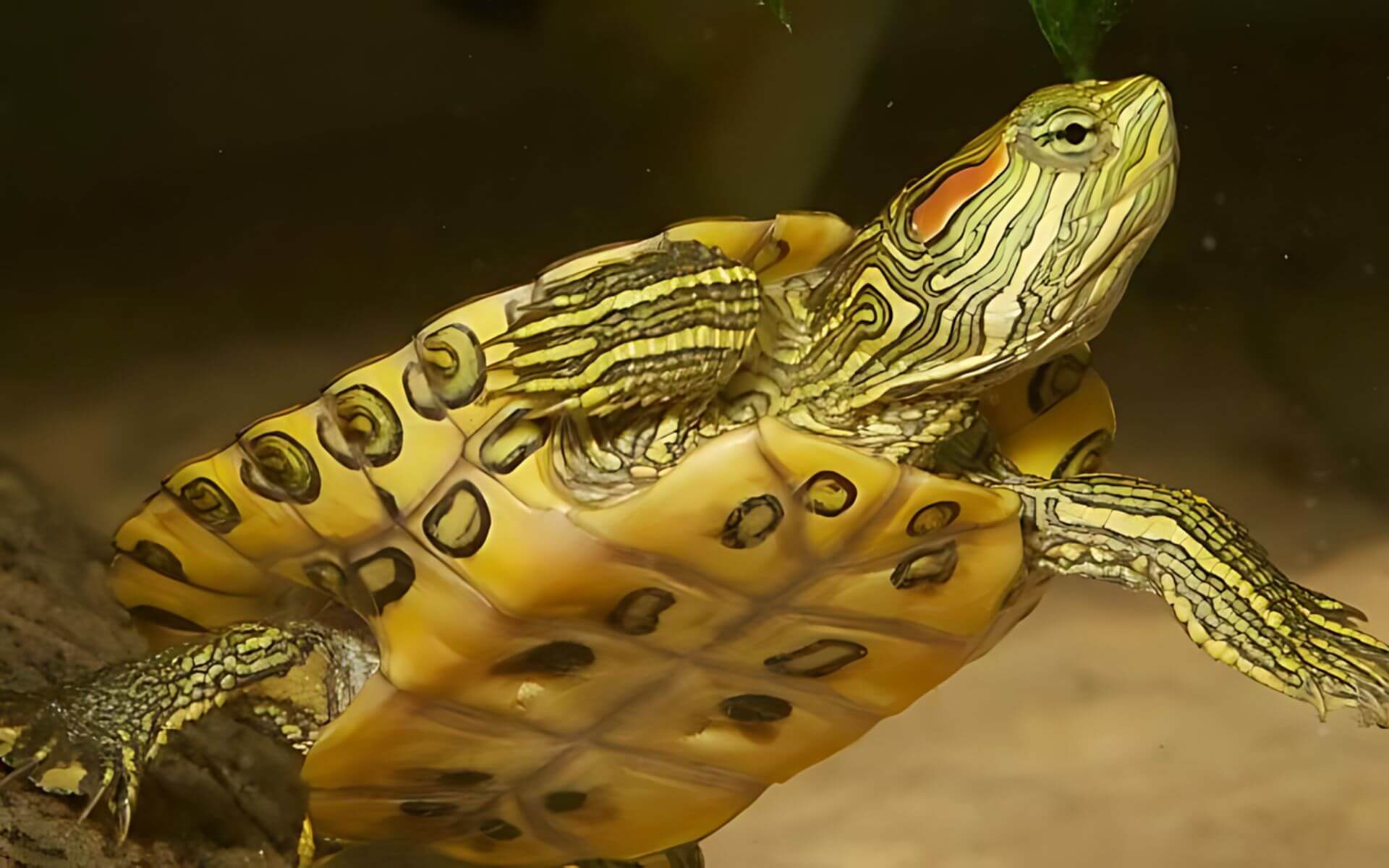Red-eared sliders are a popular reptile pet that we see very commonly at Mesa Veterinary Hospital. However, their care can be very difficult! Below is information on the care for these wonderful reptiles.
Scientific name: Trachemys scripta elegans
Native to the United States east of the Rockies. They are freshwater turtles.
Husbandry concerns: All red-eared sliders need both a warm, dry area and a large pool of warm water. In the wild, they choose water that warms up quickly in the sun each day. You will need to provide a warm enclosure with both heated water and a warm place for your turtle to climb out and dry off. The water must be kept clean! Rotting bits of food mixed with feces will combine to make an unhealthy habitat. See below for specific information on how to design your turtle’s new home.
You can use clean aquarium rock and gravel to build a slope up from the wet end (the pool) to the dry end (the land). Floating or anchored cork rafts or logs are another alternative. Rough rocks must not be used as they can scratch turtle shells which allows bacterial and fungal infections to get started and penetrate into the turtle’s body.
One of the biggest mistakes that aquatic turtle owners make is not providing a large enough tank for their turtle. The minimum size required for a young turtle will not work for a middle-aged or full-grown turtle. Since turtles will grow relatively quickly when they are cared for properly, you should start off with an enclosure size big enough for your turtle to comfortably grow into for at least 1-2 years. For the smallest turtles, start with at least a 30-50 gallon glass aquarium. The water must be at least 2 times your turtle’s total length in depth, with several extra inches of air space between the surface of the water to the top edge of the tank to prevent escapes. The tank length needs to be at least 5 times the turtle’s length, and the front-to-back width should be at least 3 times the turtle’s length. Having two turtles can be fun, but then your tank should be twice the size to accommodate both of them!
Proper water filtering systems are necessary to keep the water fairly fresh between your weekly changes. If you have a powerful filter system and you feed your turtle in another tank, you may be able to get away with replacing 25-50% of the water each week for two or three weeks, emptying and cleaning out the tank thoroughly every third or fourth week. Remember to replace the water with warm water. You will also need some type of automated siphon for the partial changes of water between the overall heavy-duty changes and cleaning.
The water temperature must be maintained between 75-86 degrees F. If you buy a submersible pre-calibrated heater, test it first and make sure the water is the proper temperature before you put your turtle in the water. Use a heat lamp above the dry area to create a basking area, which should reach 85-88 F. It is VERY important that you do not guess at either of these temperatures and that they are directly measured! Their requirements are very specific and they can become very ill if these temperatures are too low.
Turtles also require specialized lighting, called UVB lighting. The best source of UVB is the sun, but if your turtle is remaining indoors a special light needs to be purchased. ReptiSun and Megaray are two great options, but these lights can be purchased at pet stores as well. Be sure to read the box carefully, as most UVB lights only emit UVB for approximately 6 months! This means the fluorescent light will still be present, but no UVB is being emitted. Be sure to label the light fixture with the month the bulb should be changed. UVB light also does not go through glass or plastic, and should be within 18 inches of the turtle’s basking area. Make sure there is absolutely no way for the lights to fall into the water or for the turtle to come into direct contact with the light bulbs. Make sure that all lights are securely fixed so they cannot be moved.
Diet: Red eared sliders are omnivores, eating both animal protein and vegetable/plant matter. Younger turtles need up to 40% of their food from protein sources. Adult turtles feed more heavily on vegetation. All red eared sliders should be fed a varied diet. Young turtles should be fed daily, where adults can be fed every other day. Do not feed more than they can eat, as the excess food will just dirty the water.
There are a few different categories of foods to obtain for your turtle. Commercial foods are very common and convenient, but should be only 25% of your turtle’s diet. Animal protein should make up another 25% of the diet. This can include live feeder fish (NOT frozen fish), earthworms, cooked beef and chicken (sparingly). Earthworms can be gut loaded so that they contain added vitamins and minerals. A gut loading formula (such as those made by Flukers) can be purchased and fed to the worm before it is fed to the turtle. Plant matter should compose the remainder of the diet, around 50%. Examples of foods to try include dark leafy greens (collard, mustard, and dandelion), shredded carrots, squash, and green beans. Fresh vegetables are better, but frozen vegetables can be fed occasionally as well. Some fruits can also be offered, such as apples, melons, and berries.
Health care: It can be difficult to know whether your turtle is healthy or not, and an annual exam to discuss husbandry and thoroughly examine your turtle is recommended. At that time a routine fecal exam may be recommended, and potentially other tests depending on how your turtle is doing. Common signs of illness including closed or swollen eyes, breathing with their mouth open, discharge around the nose or mouth, not eating, swimming abnormally, or abnormalities of the shell.
Other information:
Life span: Some have been reported to live for over 100 years.
Sexing: Males are smaller than females in overall body size but have longer tails and toenails.
*All reptiles can carry salmonella, which can be transmitted to humans. Wash your hands thoroughly after handling*
If you have any questions about the care of your red-eared slider or are interested in adding one to the family, give us a call!

